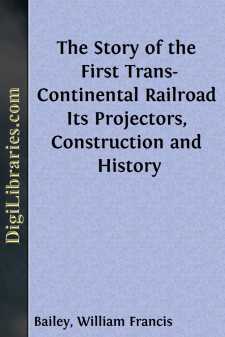Categories
- Antiques & Collectibles 13
- Architecture 36
- Art 48
- Bibles 22
- Biography & Autobiography 813
- Body, Mind & Spirit 142
- Business & Economics 28
- Children's Books 13
- Children's Fiction 10
- Computers 4
- Cooking 94
- Crafts & Hobbies 4
- Drama 346
- Education 46
- Family & Relationships 57
- Fiction 11828
- Games 19
- Gardening 17
- Health & Fitness 34
- History 1377
- House & Home 1
- Humor 147
- Juvenile Fiction 1873
- Juvenile Nonfiction 202
- Language Arts & Disciplines 88
- Law 16
- Literary Collections 686
- Literary Criticism 179
- Mathematics 13
- Medical 41
- Music 40
- Nature 179
- Non-Classifiable 1768
- Performing Arts 7
- Periodicals 1453
- Philosophy 64
- Photography 2
- Poetry 896
- Political Science 203
- Psychology 42
- Reference 154
- Religion 513
- Science 126
- Self-Help 84
- Social Science 81
- Sports & Recreation 34
- Study Aids 3
- Technology & Engineering 59
- Transportation 23
- Travel 463
- True Crime 29
The Story of the First Trans-Continental Railroad Its Projectors, Construction and History
Categories:
Description:
Excerpt
Preface
For some reason the people of today are not nearly as familiar with the achievements of the last fifty years as they are with those of earlier days.
The school boy can glibly recount the story of Columbus, William Penn, or Washington, but asked about the events leading up to the settlement of the West will know nothing of them and will probably reply "they don't teach us that in our school"—and it is true. Outside of the names of our presidents, the Rebellion, and the Spanish-American War, there is practically nothing of the events of the last fifty years in our school histories, and this is certainly wrong. "Peace hath her victories as well as War," and it is to the end that one of the great achievements of the last century may become better known that this account of the first great Pacific Railroad was written.
It was just as great an event for Lewis and Clark to cross the Rockies as it was for Columbus to cross the Atlantic. The Mormons not only made friends with the Indians as did Penn, but they also "made the desert to blossom as the rose," and Washington's battles at Princeton, White Plains, and Yorktown were but little more momentus in their results than Sandy Forsythe's on the Republican, Custer's on the Washita, or Crook's in the Sierra Madre.
The construction of the Union Pacific Railroad was of greater importance to the people of the United States than the inauguration of steamship service across the Atlantic or the laying of the Atlantic Telegraph. Yet the one has been heralded from time to time and the other allowed to sink into temporary obscurity.
To make good Americans of the coming generation all that is necessary is to make them proud of American achievements and the West was and is a field full of such.
The building of the Pacific Railroad was one of the great works of man. Its promoters were men of small means and little or no financial backing outside of the aid granted them by the Government. It took nerve and good Yankee grit to undertake and carry out the project. How it was done it is hoped the succeeding pages may show.
Fair Oaks, California, 1906.
Poem read at the Celebration of the opening of the Pacific Railroad, Chicago, May 10th, 1869.
Ring out, oh bells. Let cannons roar
In loudest tones of thunder.
The iron bars from shore to shore
Are laid and Nations wonder.
Through deserts vast and forests deep
Through mountains grand and hoary
A path is opened for all time
And we behold the glory.
We, who but yesterday appeared
But settlers on the border,
Where only savages were reared
Mid chaos and disorder.
We wake to find ourselves midway
In continental station,
And send our greetings either way
Across the mighty nation.
We reach out towards the golden gate
And eastward to the ocean.
The tea will come at lightning rate
And likewise Yankee notions.
From spicy islands off the West
The breezes now are blowing,
And all creation does its best
To set the greenbacks flowing.
The eastern tourist will turn out
And visit all the stations
For Pullman runs upon the route
With most attractive rations.
—From the Chicago Tribune, May 11th, 1869.
The First Trans-continental Railroad.
CHAPTER .
The Project and the Projectors.
President Jefferson First to Act on a Route to the Pacific — Lewis and Clark Expedition — Oregon Missionaries — Railroad Suggested — Mills 1819 — The Emigrant 1832 — Parker 1835 — Dr. Barlow's Plan — Hartwell Carver's — John Plumbe's — Asa Whitney — Senator Benton's National Road.
It would appear that Thomas Jefferson is entitled to the credit of being the first to take action towards the opening of a road or route between the eastern states and the Pacific Coast. While he was in France in 1779 as American Envoy to the Court of Versailles he met one John Ledyard who had been with Captain Cook in his voyage around the world, in the course of which they had visited the coast of California. Out of the acquaintance grew an expedition under Ledyard that was to cross Russia and the Pacific Ocean to Alaska, thence take a Russian trading vessel from Sitka to the Spanish-Russian settlement on Nookta Sound (Coast of California) and from there proceed east overland until the settlements then confined to the Atlantic Seaboard were reached....


